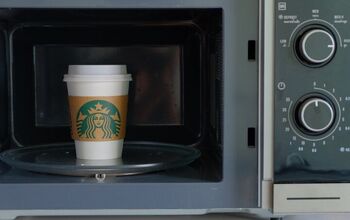Can You Microwave Ziploc Bags? (Find Out Now!)

These days, you’ll find Ziploc bags in just about any home. Ziploc bags are convenient for a bunch of different reasons, and so many things can be stored in Ziploc bags, food items being the most common.
With this being the case, many wonder if Ziploc bags are microwave-safe? Will the microwave alter what’s inside the bag? Will it melt?
While the idea that Ziploc bags are microwave-friendly has been promoted by leading brands like Rubbermaid, Tupperware, and Gladware, there are some who believe that Ziploc bags cannot withstand the high heat a microwave produces. This article will explain the thinking on both sides.
Yes, you can microwave Ziploc bags, but you need to be careful when doing so. If you don’t do things right, you could risk melting the bag, damaging the microwave, creating a mess, and/or contaminating what’s inside the bag. Only use the low-power mode and heat for about 30 seconds. Never cook with a Ziploc bag.
Do You Need Appliance Repair Services?
Get free, zero-commitment quotes from pro contractors near you.

Is It Safe to Put a Ziploc Bag in the Microwave?
Ziploc bags are indeed durable- but are they safe and sturdy enough to be used in the microwave?
According to the FDA, Ziploc baggies meet the necessary safety requirements in order to be used in the microwave. These bags are made of polyethylene low density (LDPE) and polyethylene linear low density (LLDPE), which are derivatives of crude oils.
Polyethylene materials are what allow Ziploc bags to be stable in high heat and low-temperature settings. Most plastics cannot be used in microwaves due to the risk of toxins being released into the air and the items losing their shape.
It’s important to note that Ziploc products are also bisphenol A (BPA) free!
Properties of Ziploc Bags
Ziploc bags are made of a material called film. Film is a clear, thin plastic that’s constructed using high-density polyethylene. This also goes by the names HDPE and recycling #2. There is also low-density polyethylene, and this is referred to as LDPE or recycling #4.
Plastic packaging will include a number at the bottom, and this indicates how many polymers were used to construct the package. One should also know that Ziploc bags are BPA-free, and they don’t include dioxin either. Ziploc bags are also recyclable, yet they’re not made out of recycled materials.
Since Ziploc bags are made out of polyethylene plastic, they will begin to soften at around 190°F or 90.5°C. For this reason, a plastic bag will melt in boiling water, as water boils at 212°F or 100°C. You should know this before you pour boiling water into a Ziploc bag, and you should refrain from putting a Ziploc bag in boiling water.
Which Ziploc Bags Can Be Used in the Microwave?
Ziploc offers a variety of products- some bags have a press-fit seal, while others come with a plastic zipper. Are all of these safe to use in the microwave?
Here’s a comprehensive list of Ziploc baggies that are microwave safe:
- Sandwich bags
- Vacuum-seal bags
- Double-zipper bags
- Easy-open tab bags
- Slider bags
- Stand-and-fill bags
- Gallon storage bags
- 50-quart storage bags
- Freezer bags
Any of these can be easily thrown in the microwave. However, it’s important to adhere to certain guidelines when doing so.
What Other Ziploc Products Are Microwave-Safe?
Ziploc bags are safe, so what about tupperware or other items?
Other approved, microwave safe Ziploc products include:
- Square containers (deep, regular, and mini)
- Rectangle containers (deep, regular, mini, and divided)
- Round containers (Twist ‘N Loc medium and small)
- Fresh start variety pack
- Leftover pack variety
- Lunch pack
- Soups, sauces, and sides pack
- Twist ‘N Loc and Press & Seal variety pack, 40-piece
All of these Ziploc containers are microwave safe, although we recommend reheating your food without the lid on. Instead, place a paper towel on top and use the steps detailed above to safely nuke your meal!
Microwaving Ziploc Bags: What the Manufacturer Says
While using a Ziploc bag in the microwave is possible, such doesn’t mean that doing so is safe. Before you put a Ziploc bag in the microwave, you should take a look at the bag’s label. This important information is provided by Ziploc on their website:
“When label directions are followed, Ziploc® brand products can be used with confidence. All Ziploc® brand Containers and microwavable Ziploc® brand Bags meet the safety requirements of the U.S. Food and Drug Administration (FDA) for temperatures associated with defrosting and reheating food in microwave ovens, as well as room, refrigerator and freezer temperatures.”
Defrosting and Reheating vs. Cooking
Ziploc only says their bags can be used for defrosting and reheating, which means that straying from these purposes is not recommended. You should definitely not attempt to cook with a Ziploc bag, and manufacturer’s directions explicitly advise against this.
If you cook a bag, the water’s temperature will exceed the bag’s melting point, and the same can’t be said for when you’re just defrosting or reheating. You should also avoid steaming with a Ziploc bag, as steam can actually be hotter than boiling water.
You shouldn’t assume that just because Ziploc bags are microwavable that regular sandwich bags are as well. You should consult the manufacturer’s instructions before you place a plastic bag in the microwave, as the bag may not be suitable for the microwave.
You can put freezer bags in the microwave, but again you should stay away from using a lot of heat. This is because freezer bags, despite their reinforced material, will melt if a certain temperature is reached, just like with all other Ziploc bags.
Using a Ziploc Bag in the Microwave: What to Do
If you’re going to use a Ziploc bag in the microwave, you need to put the bag on a microwave-friendly dish. You should handle the bag with care, especially when you’re placing it on the dish.
If the contents of the bag don’t get hot right away, you shouldn’t immediately do more heating, as you may melt the bag. There are no clear defrosting and reheating standards set by the manufacturer; they only say you shouldn’t overheat as the bags may melt.
In general, you can microwave a Ziploc bag on low-power mode for about 30 seconds. Make sure the bag is unsealed, as doing so will prevent steam buildup. After 30 seconds is over, inspect the bag to make sure it hasn’t been compromised by the heat.
More Things You Should Know
Since many individuals wanted Ziploc bags that were definitively microwave-safe, the company started manufacturing sealable plastic bags that are designed specifically for the microwave.
Still, the company stresses avoiding overheating, and they also say you should avoid heating high-fat and sugary items, as these can heat to much higher temperatures than water. And if they get too hot, they can melt right through a Ziploc bag.
Again, you should only stick to reheating and defrosting with these bags, and these bags won’t withstand the temperature of boiling water. Stick to the low-power, 30-second rule when using the bags, and even though they’re sealable, there should be a little break in the seal to prevent steam buildup.
If you’re using Ziploc bags for meal prep, you need to cut the food into small, uniform pieces. Doing so will ensure the food cooks fast in the microwave. This way, you don’t run the risk of overheating the bag.
What to Know About Temperatures
Excessive heat is the main thing that can damage a Ziploc bag in the microwave, and this is why the manufacturer only recommends using a mildly hot temperature. You should not let the microwave exceed 170°F, as doing so will likely permanently warp the Ziploc bag. And if you go any higher than this, there’s a chance you could reduce your Ziploc bag to a puddle of plastic.
One thing you should keep in mind is that it’s notoriously hard to control exact temperature inside a microwave. For this reason, you should set the range to between 165°F and 170°F. Time is the important factor when using a microwave; not temperature. Below is an explanation of how long it’ll take a microwave to reach 170°F:
- An average 700-watt microwave will boil a cup of water in just about three minutes; water’s boiling point is 212°F.
- Therefore, an average microwave, set to an average heating setting, will take about two minutes to reach 170°F.
- If you leave a Ziploc bag in the microwave for longer than two minutes straight, it will probably start to warp.
Health Risks Associated With Melting Plastic Bags
A lot of Ziploc bags are made of low-density polyethylene plastic, but there are some high-density plastic products as well. Research has been done to see how plastic usage is linked to cancer and a number of other illnesses, but there isn’t a lot of research that focuses on this specific kind of plastic.
What’s clear is that Ziploc bags are made out of a relatively safe plastic. Therefore, if you put them in the microwave, you probably don’t have anything to worry about, even if there is a little bit of melting.
Of course, you don’t want to be knowingly consuming plastic, but a little tiny bit won’t hurt. Excessive plastic consumption can disrupt the body and wreak havoc. You may experience indigestion and neurological problems. Cancer, asthma, and other ailments are also linked to excessive plastic consumption.
Do You Need Appliance Repair Services?
Get free, zero-commitment quotes from pro contractors near you.

Related Questions
Is it possible to steam vegetables with a Ziploc bag?
With a little bit of finesse and constant attention, you could steam vegetables using a Ziploc bag, but you really should avoid doing so, as it’s hard to predict when steam is going to get hot quickly.
Furthermore, once this happens you really can’t do a lot to control the heat fluctuations. If you need to steam vegetables, it’s best to use a bag that can handle this. Or you should just pursue another means of steaming. You don’t want steaming to come at the cost of you melting plastic on your vegetables.
Aren’t freezer bags stronger than Ziploc?
While freezer bags are made of reinforced materials, you shouldn’t take them out of the freezer and immediately put them in the microwave. At least give a brief window of time to natural defrosting, as too much microwave time could lead to the releasing of harmful dioxins.
Even with freezer bags, you need to make sure there’s no full seal. If there’s a full seal, the steam buildup will reduce significantly the time a Ziploc bag should be in the microwave.
Can you pour boiling water into a Ziploc bag?
The answer is: absolutely not. As we mentioned above, any temperature above 195 degrees Fahrenheit will ruin the structure of the Ziploc bag.
At sea level, water boils at around 212 °F, making it unsafe to pour inside of a plastic bag. The most optimal structure to pour boiling water into is a ceramic or metal bowl.
Just be sure to use caution when handling, as you could burn yourself!

Matt loves everything DIY. He has been learning and practicing different trades since he was a kid, and he's often the first one called when a friend or family member needs a helping hand at home. Matt loves to work with wood and stone, and landscaping is by far his most favorite pastime.
More by Matthew Mountain



























